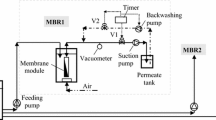Abstract
As one of the main industrial pollutants, aromatic solvents such as benzene, toluene, and xylenes (collectively known as BTX) have been causing the detrimental effects on environment 1-5]. Much effort has been made on the elimination of these compounds from a waste stream, and various methods have been reported [3-5]. In biological treatment system, three types of processes have been developed: bioscrubber, trickling filter, and biofilter[3,5]. Because of low solubility in water and high volatility, BTX are usually fed into the degradation process in gas phase with air stream [3]. In conventional processes, however, volumetric degradation rate was relatively low, less than 0.04 g/L/h, and efficient control of operational conditions such as moisture content in the bed and transfer rate of compounds to be treated was reported to be difficult to realize [3].
Access this chapter
Tax calculation will be finalised at checkout
Purchases are for personal use only
Preview
Unable to display preview. Download preview PDF.
Similar content being viewed by others
References
Hutchins, S.R., Sewel, G.W., Kovaks, D.A., Smith, G.A. 1991. Biodégradation of Aromatic Hydrocarbons by Aquifier Microorganisms under denitryfying Condition, Environ. Sci. echnol. 25 (1): 68–76.
Kobayashi, H., Rittmann, B.E. 1982. Microbial Removal of Hazardous Organic Compounds. Environ. Sci. Technol. 16 (3): 170–183.
Ottengraf, S.P.P. 1986. “Exhaust Gas Purification” in Biotechnology Vol.8. Rehm, H.J., and Reed, G. (ed), pp 425 –452.
Pettigrew, C.A., Heiger, B.E., Spain, J.C. 1991. Simultaneous Biodégradation of Chlorobenzene and Toluene by Pseudomonas strain. Appl. Environ. Microbiol. 57 (1): 157–162.
Stensel, H.D., Reiber, S. 1983. Industrial Waste Water Tratment With a New Biological Fixed-Film System. Environ. Prog. 2 (2): 110–114.
Weatherburn, M.W. 1967. Phenol-Hypochlorite Reaction for Determination of Ammonia. Anal. Chem. 39: 426 –428
Author information
Authors and Affiliations
Editor information
Editors and Affiliations
Rights and permissions
Copyright information
© 1992 Springer-Verlag Tokyo
About this paper
Cite this paper
Yong-Bok, C., Jang-Young, L., Hak-Sung, K. (1992). A Novel Bioreactor for the Biodegradation of Toxic Aromatic Solvents. In: Furusaki, S., Endo, I., Matsuno, R. (eds) Biochemical Engineering for 2001. Springer, Tokyo. https://doi.org/10.1007/978-4-431-68180-9_214
Download citation
DOI: https://doi.org/10.1007/978-4-431-68180-9_214
Publisher Name: Springer, Tokyo
Print ISBN: 978-4-431-68182-3
Online ISBN: 978-4-431-68180-9
eBook Packages: Springer Book Archive




